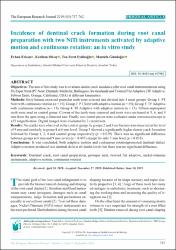| dc.contributor.author | Erkan, Erhan | |
| dc.contributor.author | Olcay, Keziban | |
| dc.contributor.author | Eyüboğlu, Tan Fırat | |
| dc.contributor.author | Gündoğar, Mustafa | |
| dc.date.accessioned | 2022-04-07T06:49:28Z | |
| dc.date.available | 2022-04-07T06:49:28Z | |
| dc.date.issued | 2019 | en_US |
| dc.identifier.citation | Erkan, E., Olcay, K., Eyüboğlu, T. F. ve Gündoğar, M. (2019). Incidence of dentinal crack formation during root canal preparation with two NiTi instruments activated by adaptive motion and continuous rotation: An in vitro study. The European Research Journal, 5(5), 757-762. https://doi.org/10.18621/eurj.417982 | en_US |
| dc.identifier.issn | 2149-3189 | |
| dc.identifier.uri | https://doi.org/10.18621/eurj.417982 | |
| dc.identifier.uri | https://hdl.handle.net/20.500.12511/9241 | |
| dc.description.abstract | Objectives: The aim of this study was to evaluate dentin crack incidence after root canal instrumentation usingProTaper Next (PT Next; Dentsply Maillefer, Ballaigues, Switzerland) and Twisted File Adaptive (TF Adaptive;Sybron Endo, Orange, California, USA) at different kinematics.Methods: Sixty human extracted premolar teeth were selected and divided into 4 main groups. Group 1: PTNext with continuous rotation (n = 15); Group 2: PT Next with adaptive motion (n = 15); Group 3: TF Adaptivewith continuous rotation (n = 15); Group 4: TF Adaptive with adaptive motion (n = 15). Fifteen unpreparedteeth were used as control group. Crowns of the teeth were removed and roots were sectioned at 3, 6, and 9mm from the apex using a diamond saw. Finally root dentin pieces were evaluated under stereomicroscope atx25 magnification. Digital images were evaluated by 2 researchers.Results: No cracks were observed in the control group. In groups 2 and 4 no fracture was observed at the levelof 9 mm and similarly in group 4 at 6 mm level. Group 3 showed a significantly higher dentin crack formationfollowed by Group 1, 2, 4 and control group respectively (p < 0.039). There was no significant differencebetween groups at 6 mm and 9 mm levels (p = 0.497) except for only 3 mm level (p < 0.035).Conclusions: It was concluded, both adaptive motion and continuous rotationpromoted dentinal defect.Adaptive motion produced less dentinal defects all dentin levels but there was no significant difference. | en_US |
| dc.language.iso | eng | en_US |
| dc.rights | info:eu-repo/semantics/openAccess | en_US |
| dc.rights | Attribution-NonCommercial-NoDerivatives 4.0 International | * |
| dc.rights.uri | https://creativecommons.org/licenses/by-nc-nd/4.0/ | * |
| dc.subject | Dentinal Crack | en_US |
| dc.subject | Root Canal Preparation | en_US |
| dc.subject | Protaper Next | en_US |
| dc.subject | Twisted File Adaptive | en_US |
| dc.subject | Nickel-Titanium Instruments | en_US |
| dc.subject | Adaptive Motion | en_US |
| dc.subject | Continuous Rotation | en_US |
| dc.title | Incidence of dentinal crack formation during root canal preparation with two NiTi instruments activated by adaptive motion and continuous rotation: An in vitro study | en_US |
| dc.type | article | en_US |
| dc.relation.ispartof | The European Research Journal | en_US |
| dc.department | İstanbul Medipol Üniversitesi, Diş Hekimliği Fakültesi, Endodonti Ana Bilim Dalı | en_US |
| dc.authorid | 0000-0003-2631-3286 | en_US |
| dc.authorid | 0000-0002-2168-710X | en_US |
| dc.authorid | 0000-0002-0308-9579 | en_US |
| dc.authorid | 0000-0002-6394-0791 | en_US |
| dc.identifier.volume | 5 | en_US |
| dc.identifier.issue | 5 | en_US |
| dc.identifier.startpage | 757 | en_US |
| dc.identifier.endpage | 762 | en_US |
| dc.relation.publicationcategory | Makale - Ulusal Hakemli Dergi - Kurum Öğretim Elemanı | en_US |
| dc.identifier.doi | 10.18621/eurj.417982 | en_US |
| dc.institutionauthor | Erkan, Erhan | |
| dc.institutionauthor | Olcay, Keziban | |
| dc.institutionauthor | Eyüboğlu, Tan Fırat | |
| dc.institutionauthor | Gündoğar, Mustafa | |



















